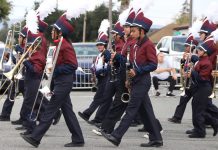After receiving the go-ahead from archaeological consultants,
the Aromas-San Juan School District has resumed construction on an
athletic field project previously delayed after questions arose
about the presence of artifacts.
After receiving the go-ahead from archaeological consultants, the Aromas-San Juan School District has resumed construction on an athletic field project previously delayed after questions arose about the presence of artifacts.
The district initially began working on the ball fields, next to San Juan School on The Alameda, at the end of August. But the project – two soccer fields and two baseball fields on six acres – halted after debate arose on the archaeological impact of the field’s irrigation system.
The district hired Mary Doane and Gary Breschini with Salinas-based Archaeological Consulting to do a study of the land and the impact of the project.
They concluded that there were no artifacts damaged by the field project and the district could move forward – while keeping an archaeologist available to monitor any deep trenching.
“There was nothing that indicated that there was any kind of buried resource there,” said Doane, who serves as project director. “We couldn’t find anything but we’re keeping an eye on it.”
Joseph Reyes, the district’s operations manager, said the district would be finishing grading this week and starting to lay out the irrigation system, with trenching set for next week.
“Being that we’re in such close proximity to the mission, we’re going to have an archaeologist on hand,” he said.
During the trenching process, there will be both an archaeologist and an individual with the local American Indian tribe to observe.
Doane said while there were many historical artifacts throughout the field, the majority came from the late 1800s and early 1900s.
“There was a lot of material that was historic in nature that had been spread across the field through time, but there was very little that was associated with the mission,” Doane said.
The primary materials found to be associated with neophyte housing and the mission were roof-tile fragments, typical of housing from that era, she said.
Part of the difficulty in assessing the historic pieces is that it appears some artifacts had been transferred from other locations throughout San Juan Bautista, because the site served as a sort of dumping ground for some time.
“We did an intensive survey, back and forth throughout that field,” Doane said. “We found that the materials were more toward where there had been a more recent dumping area.”
The archaeologists recommended that San Juan School collect any of the interesting artifacts and create an educational display.
Depending on the weather, Reyes said he hopes to plant grass on the field in about three weeks and the fields should be ready for student use by early summer.









